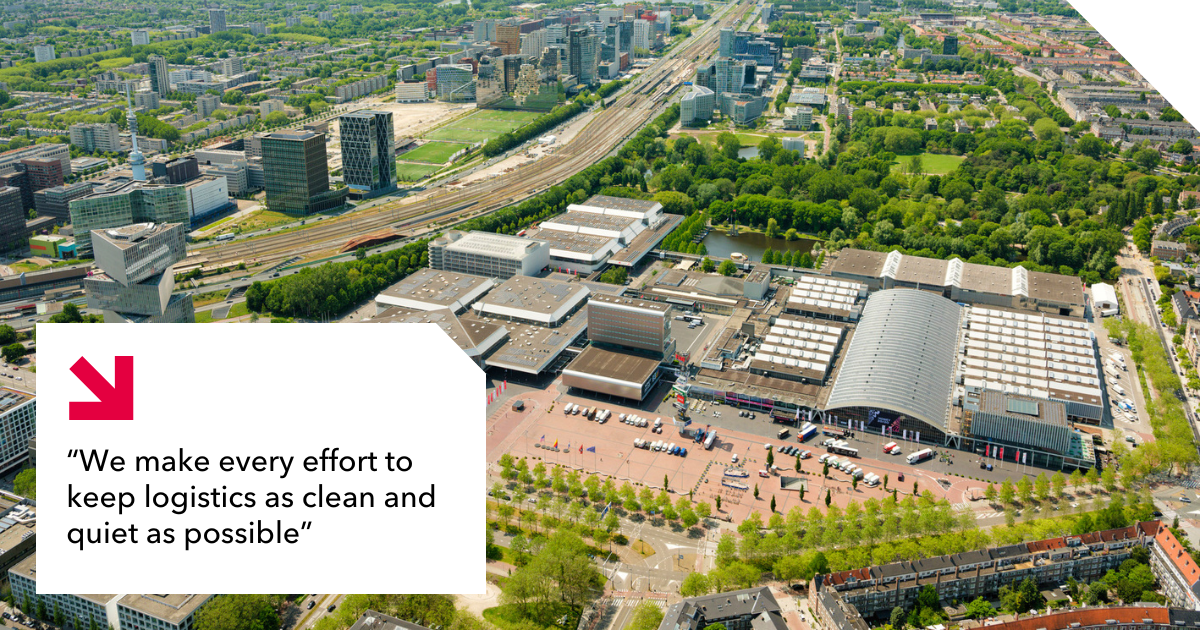More efficient, quieter, cleaner: Event logistics 2.0
An event venue like RAI Amsterdam, right in the heart of the city, is ideal for visitors. At the same time, we do everything we can to keep logistics as clean and quiet as possible. A lot has been achieved in recent years. Thanks to tight coordination and the use of new technologies, freight traffic around the RAI has been reduced and is now more evenly spread throughout the day.
Traffic & Logistics Manager Wim Braakman is always looking for ways to minimise nuisance and emissions from event-related transport. His work may not always be in the spotlight, because he mainly makes things disappear: fewer transport movements, less noise, less nuisance.
Looking ahead
Every two years, we have this conversation, and what was just a plan two years ago is now reality. “We’re always looking ahead,” agrees Wim. “Whether it’s about sustainability or traffic congestion — if you want to achieve something in five years from now, you have to start today.
Taking control: 95% scheduled within time slots
In 2024, around 20,000 transport movements were recorded for the supply of event material. 95% of the trucks booked a time slot. “That’s essential,” says Wim. “Without a reservation, you can't access the site. We enforce this strictly — but it actually benefits everyone. The flow of traffic improves, drivers no longer have to wait, and the supply in the halls are more evenly spread. It's more efficient, safer, and cleaner.”
Buffer zones hardly needed anymore
A buffer zone in Westpoort is available where trucks can wait before accessing the RAI. “At this point, it’s only really used for two major events — IBC and PLMA,” says Wim. “And even those events rely far less on the area during the build-up phase, thanks to the timeslot system. Dismantling is harder to schedule, so the buffer zone is still helpful in that phase. For other events, the zone is already too large.”
This year, the RAI also signed a usage contract for a smaller buffer zone, known as P18/P19. Wim: “This area is closer to the RAI, just across the highway, and serves multiple functions. For example, it can be used for parking vehicles whose drivers are helping the build-up, or someone who forget to book a time-slot.
From 10 vehicles to 1
Not all event materials arrive in full trailers. Sometimes they come in smaller box trucks or as part-loads. Moreover, it’s not always possible to deliver everything on the day of the build-up. For this, the RAI uses a transhipment site, which moved to the brand-new CT Park in Amsterdam’s Western Harbour District in February 2025. “Last year, 1,600 vehicles arrived at our transhipment site,” Wim explains. “We transfer the goods into (electric) vehicles, which then deliver everything to the RAI in one go, at exactly the right time. This reduces the number of vehicle movements into the city by 90%. Plus, we can plan them very precisely. It’s convenient for organisers too — they can deliver in advance, avoid city access, and don’t need a time slot."
Electric forklifts
Electric transport is the norm within the RAI. Since November 2024, DB Schenker has been operating the first series of fully electric forklifts on the RAI site. These are quieter, cleaner, and safer. The new generation of forklifts is also equipped with additional cameras and extra light strips at the front and rear.
What you reuse doesn’t need transporting
Although it’s not Wim’s department, he is a big supporter of modular, reusable stand construction. “Instead of custom-made stands, you work with building blocks such as reusable plastic wall panels, modular components, or metal frames covered with printed fabric. Through branding, lighting and finishes, everything can still be fully personalised. It requires less material, can be delivered in one go, and we can store and reuse it. That is of course the best-case scenario — not having to transport it at all.”
From outside to inside
“With the timeslot system, transhipment and buffer zones, we have done pretty much everything we can on the outside the halls of RAI Amsterdam,” says Wim. “Now we’re turning our attention inward. Because if you optimise everything outside, you also need to manage the flow of unloading and redistributing inside the halls to the final destination. If you don’t bring everything directly to the stand, the truck can leave the site more quickly. Inside, there is more flexibility and we can deliver materials to exhibitors in a more controlled, gradual way. We’re currently exploring how to implement this in practice.”
Data analysis for greater control
Finally, more and more data is becoming available on logistics flows. Wim: “You can use data to answer three key questions: what exactly is happening, what level is acceptable, and how can you solve it? Take the example of people leaving a large trade show. How long does it take for all visitors to reach the highway? How long does it take without delays, and what do you consider reasonable? Then you can start adjusting the variables. We can’t do much about traffic on the highway, but we can adjust the event schedule or the closing procedure. That improves the visitor experience and reduces the burden on the neighbourhood. And that’s just one example.
